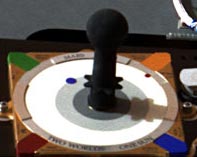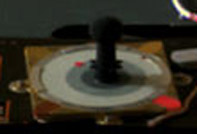
| Bad Astronomy |
|
|
|
BA Blog
|
|
Q & BA
|
|
Bulletin Board
|
| Media |
|
|
|
Bitesize Astronomy
|
|
Bad Astro Store
|
|
Mad Science
|
|
Fun Stuff
|
| Site Info |
|
|
|
Links
|
| RELATED SITES |
| - Universe Today |
| - APOD |
| - The Nine Planets |
| - Mystery Investigators |
| - Slacker Astronomy |
| - Skepticality |
Buy My Stuff

Keep Bad Astronomy close to your heart, and help make me
filthy rich. Hey, it's either this or one of those really
irritating PayPal donation buttons here.
What Color is Mars?
The question of color on Mars has come up again and again. One image of Mars shows a giant green splotch. Some images show it to have a blue sky, others a red sky, and in yet others the sky is butterscotch. Rocks look blue, or red, or green.
Of course, the pseudoscientists have jumped all over these so-called "anomalies", making the usual claims of NASA coverups and the like. But in fact what's going on is, as usual, the pseudoscientists are grossly misinterpreting the images.
Astronomical digital imaging is a fiercely complex topic. Most people assume that taking a digital picture is just like taking one with film: you point the camera, take the shot, and then look at the pretty color picture. In reality, things are a lot tougher than that. Before going on with this page, I strongly urge you to read this excellent essay about color imaging by astronomer (and my friend) Zolt Levay, who is one of the people responsible for making the gorgeous Hubble press images.
After reading that essay, you can see that astronomical images are taken in different filters. Each image is not really color, but greyscale (what some people erroneously call "black and white"), with each pixel representing the brightness of the target in the filter's color. This can be seen in the following images, which I have shamelessly stolen from Zolt's page.

|

|

|

|

|

|

|
The image on the left is a full color picture of an umbrella. The top row shows how the image has been decomposed into its three primary colors: red, green, and blue. The bottom row shows how an astronomer would take the picture, taking three greyscale images each with its appropriate filter. Note how, for example, the umbrella's yellow panel on the left changes in each greyscale image, and compare it to the yellow panel on the right, which lies partly in shadow.
The color in the final image depends on many things: the brightness in the real object (in this case, the umbrella), the filter itself (how much light does the filter let through? What color range, exactly? etc.), the lighting, the setting on your monitor, and other more arcane factors. This makes it not only difficult to make a "true color" picture; in fact it's impossible. There is simply no way to make something look in a picture exactly as it does when you are standing in front of it. Think of how color in an object can change due to just when you see it; the setting Sun makes a sheet of white paper look red, for example.
What does this have to do with Mars? Everything! The martian rovers, as an example, carry a set of filters with them. These filters are designed to maximize the science returned from Spirit and Opportunity. They are not really designed to make a "true color" picture; that is, what you would see if you were standing on Mars. When the images from Mars are returned to Earth, and then processed to make a color image, what you are seeing at best is an approximation to what your eye can see. In reality, it may be very different. The filters on the rovers do not correspond to the color sensitivity of the human eye. Some of the filters only let through infra-red light, which is invisible to our eyes!
To make these single-filter images into a color composite is not easy. If the red filter lets in less total light than the blue, you need to compensate for that when you add the images together. If the red filter is wider (lets in a wider range of reds) than the blue filter, you have to compensate for that, and so on.
 To aid in this, the scientists put a series of colored tabs or strips
around a sundial located
on the rovers to act as guides to color. They can be seen in the
image to the left. These colors (along with the grey disks in the
middle of the sundial) can be used to determine the colors in the
image.
To aid in this, the scientists put a series of colored tabs or strips
around a sundial located
on the rovers to act as guides to color. They can be seen in the
image to the left. These colors (along with the grey disks in the
middle of the sundial) can be used to determine the colors in the
image.
 The problems started when the image to the right came out.
In this image, the blue tab is now pink! What's going on?
The problems started when the image to the right came out.
In this image, the blue tab is now pink! What's going on?
If you listen to the pseudoscientists, then you will think that NASA is guilty of some sort of horrible conspiracy, possibly of trying to turn the sky of Earth into pink lemonade. In reality, though, the explanation is somewhat less sinister.
In the first picture, the blue tab looks blue because it reflects blue light. It absorbs the red and green, only letting blue light bounce off it and into our eyes. However, it turns out the paint used for the blue tab also reflects light in the infrared. Since we can't see that with our eyes, it still looks blue.
But one of the cameras onboard the rover can detect infrared. So when it looks at the blue tab, it sees blue coming from it, as well as infrared. In the infrared filter, that blue tab is actually quite bright. When that infrared filter greyscale image is used to construct a color image, the blue tab turns pink. It's not "really" pink. But then, in the other picture it's not really that exact color of blue either. Remember, the color is only an approximation.
This is why the colors in the images are a bit weird at times. Sometimes, the infrared filters are used. Other times, the way the three-color image was constructed may be too heavy in the red, or the blue, distorting the colors. Worse, as lighting changes, so do the colors! When the Sun is high, the colors look different than when it is low. The amount of dust in the air ruins the color balance as well. Even worse, dust scatters light. The sky near the Sun looks bluer in images from Mars because the dust in the air "forward-scatters" blue light; in other words it takes blue light from the Sun and focuses it more toward the camera. The sky near the Sun looks bluer, and farther away it looks redder. Light reflecting off the rocks can also suffer from all sorts of color imbalances too.
All these effects make interpreting the color pictures from Mars (or any digital scientific camera) extremely difficult to do. It ironically makes it easy for people like Hoagland to bamboozle the public into thinking some conspiracy is afoot. With my years of experience in astronomical image processing, I can see how Hoagland either doesn't understand color image processing, or doesn't want you to understand it.
Either way, it pays not to jump to conclusions. When Hoagland makes a claim, it does pay to think about it carefully, and find outside sources. Things will be much clearer, once you see the whole picture.
Links
- Much of this discussion is based on a brilliant webpage called Top Story: NASA Is Not Altering Mars Colors.
- An excellent discussion of this is ongoing on the Bad Astronomy Bulletin Board. Several people have tried to show that NASA is covering up something, but they all have been shown to be wrong.
-
The JPL Mars webpage also has
an excellent discussion of color imaging from the rovers.
©2008 Phil Plait. All Rights Reserved.This page last modified
|
|